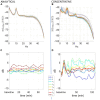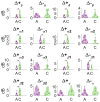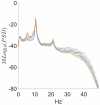Report from a Tibetan Monastery: EEG neural correlates of concentrative and analytical meditation
- PMID: 38756494
- PMCID: PMC11098278
- DOI: 10.3389/fpsyg.2024.1348317
Report from a Tibetan Monastery: EEG neural correlates of concentrative and analytical meditation
Abstract
The positive effects of meditation on human wellbeing are indisputable, ranging from emotion regulation improvement to stress reduction and present-moment awareness enhancement. Changes in brain activity regulate and support these phenomena. However, the heterogeneity of meditation practices and their cultural background, as well as their poor categorization limit the generalization of results to all types of meditation. Here, we took advantage of a collaboration with the very singular and precious community of the Monks and Geshes of the Tibetan University of Sera-Jey in India to study the neural correlates of the two main types of meditation recognized in Tibetan Buddhism, namely concentrative and analytical meditation. Twenty-three meditators with different levels of expertise underwent to an ecological (i.e., within the monastery) EEG acquisition consisting of an analytical and/or concentrative meditation session at "their best," and with the only constraint of performing a 5-min-long baseline at the beginning of the session. Time-varying power-spectral-density estimates of each session were compared against the baseline (i.e., within session) and between conditions (i.e., analytical vs. concentrative). Our results showed that concentrative meditation elicited more numerous and marked changes in the EEG power compared to analytical meditation, and mainly in the form of an increase in the theta, alpha and beta frequency ranges. Moreover, the full immersion in the Monastery life allowed to share the results and discuss their interpretation with the best scholars of the Monastic University, ensuring the identification of the most expert meditators, as well as to highlight better the differences between the different types of meditation practiced by each of them.
Keywords: Buddhist monks; EEG; analytical meditation; concentrative meditation; neural correlates.
Copyright © 2024 Neri, Callara, Vanello, Menicucci, Zaccaro, Piarulli, Laurino, Norbu, Kechok, Sherab and Gemignani.
Conflict of interest statement
The authors declare that the research was conducted in the absence of any commercial or financial relationships that could be construed as a potential conflict of interest. The author(s) declared that they were an editorial board member of Frontiers, at the time of submission. This had no impact on the peer review process and the final decision.
Figures








Similar articles
-
Electroencephalographic correlates of states of concentrative meditation.Int J Psychophysiol. 2016 Dec;110:27-39. doi: 10.1016/j.ijpsycho.2016.09.020. Epub 2016 Oct 1. Int J Psychophysiol. 2016. PMID: 27702643
-
Tibetan Buddhist monastic debate: Psychological and neuroscientific analysis of a reasoning-based analytical meditation practice.Prog Brain Res. 2019;244:233-253. doi: 10.1016/bs.pbr.2018.10.018. Epub 2019 Jan 3. Prog Brain Res. 2019. PMID: 30732839 Review.
-
The Effects of Concentrative Meditation on the Electroencephalogram in Novice Meditators.Clin EEG Neurosci. 2023 Mar;54(2):130-140. doi: 10.1177/15500594211065897. Epub 2021 Dec 13. Clin EEG Neurosci. 2023. PMID: 34894805
-
Progressive increase of high-frequency EEG oscillations during meditation is associated with its trait effects on heart rate and proteomics: a study on the Tibetan Buddhist.Cereb Cortex. 2022 Sep 4;32(18):3865-3877. doi: 10.1093/cercor/bhab453. Cereb Cortex. 2022. PMID: 34974617
-
Neural correlates of nondual awareness in meditation.Ann N Y Acad Sci. 2014 Jan;1307:9-18. doi: 10.1111/nyas.12261. Epub 2013 Sep 4. Ann N Y Acad Sci. 2014. PMID: 24033505 Review.
Cited by
-
Neurophysiological mechanisms of focused attention meditation: A scoping systematic review.Imaging Neurosci (Camb). 2025 May 28;3:IMAG.a.14. doi: 10.1162/IMAG.a.14. eCollection 2025. Imaging Neurosci (Camb). 2025. PMID: 40800838 Free PMC article.
References
-
- Benjamini Y., Yekutieli D. (2001). The control of the false discovery rate in multiple testing under dependency. Ann. Stat. 29, 1165–1188. doi: 10.1214/aos/1013699998 - DOI
LinkOut - more resources
Full Text Sources

